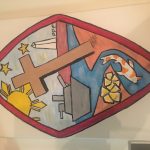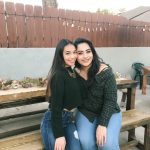To the future students of HIUS144,
Hello! My name is Ha’ani, and I am one of the first students of the Race and Oral History course offered at UC San Diego in the Spring of 2018. I was born and raised on of Guam, which is a small island in the middle of the Pacific Ocean and home to the indigenous Chamorro people. My father is Chamorro and my mother is from American Samoa, so that makes me an indigenous Pacific Islander woman. I moved to San Diego in Fall 2015 in order to attend UC San Diego, but I do travel back to Guam every winter and summer break. When I moved to the continental United States, I had a general understanding that there were heavy populations of Pacific Islanders, specifically Chamorro people, in states like California, Texas, and Washington. However, I did not fully recognize this until I came to San Diego and noticed the vast number of Chamorro people that I would encounter at large-scale events or even smaller occasions such as family gatherings or parties.
Although I was meeting these Chamorro people at these various places, I rarely came across Pacific Islanders at UC San Diego. Coming from Guam, the Chamorro people were the majority, along with Philipiinx people, so seeing that my people were a minority at this institution of higher education perplexed me. Seeing the underrepresentation of Pacific Islanders and other minority communities on campus and at-large motivated me to not only major in General Biology, but to pursue a double-major in Ethnic Studies in order to improve these conditions everywhere.
When I enrolled for HIUS144 as an upper-division course for my Ethnic Studies double-major, I honestly saw it as an easy obligation as it was only once a week. When I went to the first day of class and the syllabus was passed around, I was instantly shocked to see that this Oral History project would CHE’LU (Chamorro Hands in Education Links Unity) as it’s community partner because never have I seen the Chamorro people include in scholastic dialogue at UC San Diego. This was when my mindset changed about the course from a requirement to a labor of love.
Throughout the course, we were tasked to make site visits to CHE’LU or to Chamorro organizations associated with them such as the Sons and Daughters of Guam Club, which is where I made the majority of my visits. As a Chamorro woman who was raised on Guam and is quite knowledgeable about the history and culture of the people, I was not looking for history lessons or language comprehension of the island; however, I wanted to understand the dynamic of growing up Chamorro in the mainland United States in comparison to Guam. When I would make my routinely visits to the Sons and Daughters of Guam Clubhouse, I would frequently encounter manam’ko (elders) and hear their tales. Many of them moved to San Diego at a young age or after marriage in order to obtain a better life for their families. The Chamorro people hold families at the center of their culture and seeing that this trait of sacrifice and love is still maintained thousands of miles away from our homeland made me feel so content.
If you were to research histories or primary sources from an individual of Chamorro descent, many of these accounts are from the manam’koin order to preserve their stories and experiences from the past. In order to explore this experience of growing up Chamorro on Guam in comparison to the States, I decided to interview my good friend Francesca Camacho. Francesca, or “Chess” as I call her, and I attended high-school on Guam together and she moved to California at the same time I did to pursue a degree in law. We never really have the opportunity to discuss cultural and social issues that deal with our people, so this interview with her really allowed me to see the perspective of a young Chamorro peer. I have conducted several interviews throughout my education, but if there is one thing that I learned during this process was that oral tradition is equally important, if not more, to written sources of knowledge. Learning does not only occur in the classroom with your head in the books or taking standardized tests that last for hours on end, but sometimes the richest form of knowledge comes from interacting with strangers or even loved ones. I learned so much from my conversation with Chess about the contemporary Chamorro perspective than I would have ever learned on Google or in a lecture hall.
It is important for you to understand that this was the first quarter that this class was offered, so there were many expected obstacles to overcome. My biggest challenge was the time commitment in visiting sites, and I think this could be fixed by creating a discussion section on WebReg so that these times could serve as opportunities to visit the community partners. Another issue was the diversion from the syllabus each week, with different assignments being due at changed times. Although there were new issues each week, the overall production of an oral history that will be preserved in Geisel Library and accessible on the internet made all the stress worth it.
I can honestly say that HIUS144 was not only taken for credit, but it was also motivation to bring the Chamorro people to the forefront and show that we do exist. Students at UC San Diego need to understand the cultures and people that live in the geographic bounds of San Diego, because we are not only statistics or lines in a book or lecture but we are real and are closer than you think. Thank you HIUS144 for allowing me and my Chamorros to have a voice.
Best,
Ha’ani San Nicolas




